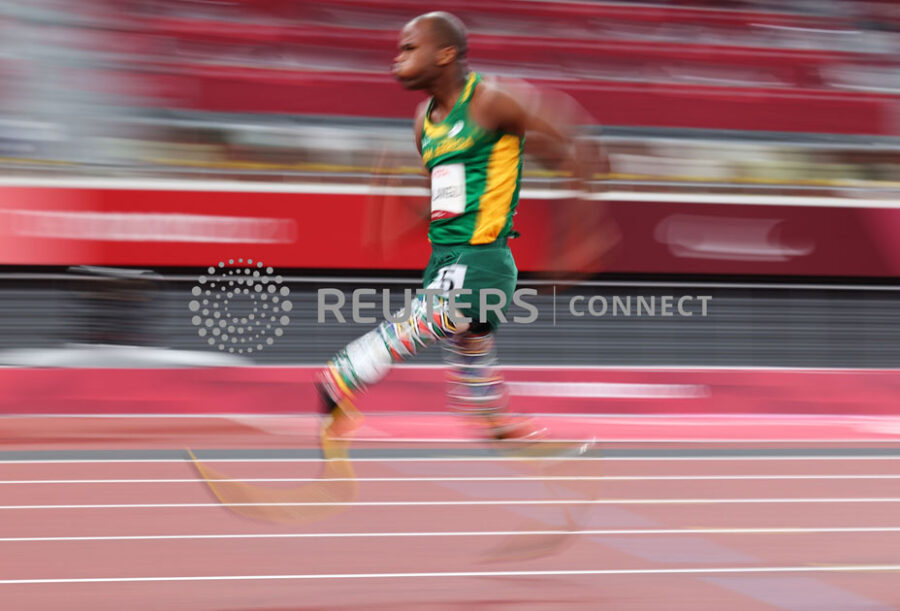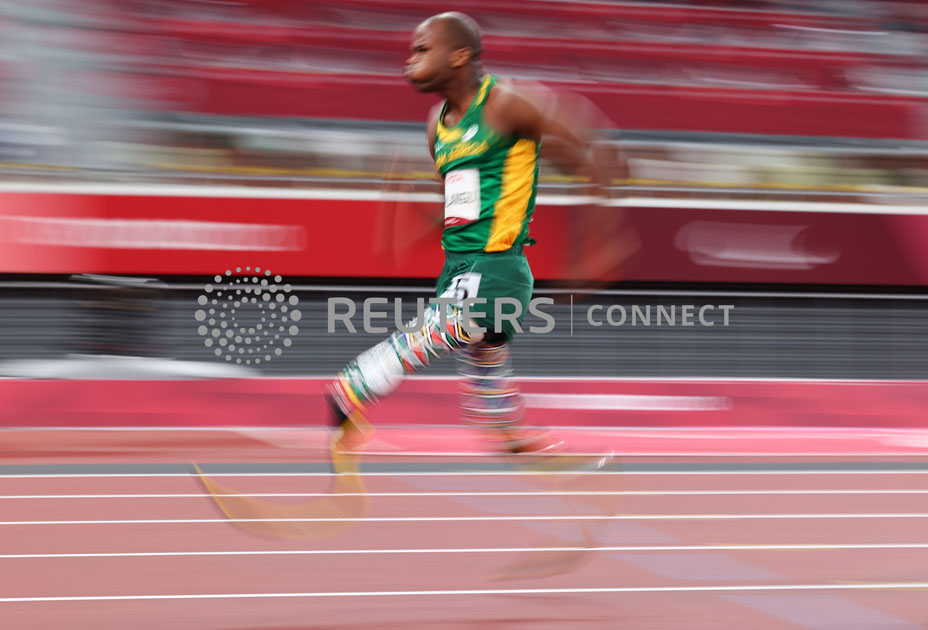
Meet the Man Behind the Blades Uplifting South Africa’s Youth at the Paralympics
More than ever, in this age of Covid-19 and the wearing of face masks, the eyes have become the window to the soul. And standing there in the mixed zone inside the Tokyo Olympic Stadium, at 9:30pm last Saturday night, was Johan Snyders. The compulsory mask hid most of his face. But not the eyes. […]

More than ever, in this age of Covid-19 and the wearing of face masks, the eyes have become the window to the soul. And standing there in the mixed zone inside the Tokyo Olympic Stadium, at 9:30pm last Saturday night, was Johan Snyders. The compulsory mask hid most of his face. But not the eyes. They were watery and red but the crumpled skin next to them told a happy story.

A few metres away, moving involuntarily from side to side on his competition blades was Ntando Mahlangu. New world-record holder in his men’s long jump classification (T61) after a final leap of 7.17m had taken him from bronze to gold, the 19-year-old was regaling the international media with his story.
And what a story it is, of a young boy at the age of 10 who had been in a wheelchair from his early days, but who had wanted to walk so desperately that he agreed to have both his legs amputated through the knees and who was now a Paralympic champion. From champion he is on a path to greatness, with Mahlangu scooping Gold again in the 200m final on Friday.

Snyders has been integral to Mahlangu’s progression and he was there when the young boy had his legs amputated.
“I met Ntando just before the 2012 London Paralympics. I did an assessment on him when I came back from London and we fitted him with a set of blades. He’s got a set of standard blades that you see him walking around on and is extremely mobile. He’s now at Afrikaans Hoër Seunskool and is currently studying for matric exams. He loves his sport and plays football as well. He did play a bit of rugby, but he’s too rough for his friends. So, he plays soccer with them.
“You have seen how mobile he is, going up and downstairs is no problem to him at all.
“The difference between him and some of the double amputees in the Paralympic Village is that Ntando just doesn’t have any fear. And that confidence comes from wearing blades. He doesn’t wear shoes, and it might be that the fact he’s so comfortable in standard blades gives him an advantage on some of his rivals.
“He’s totally in sync with blades and has the ‘normal’ ability to quickly change speed. That’s the secret.
“We fit all the kids at home with blades, and all the jumping kids wear blades.”
By now you will have got the picture: Snyders is the ‘Blades Doctor’ as much as other athletes have been dubbed ‘Blade Runners’ or ‘Blade Jumpers’.
When asked to explain what his profession is, he does so in layman’s terms, and in doing so probably undersells himself. Then again, once one starts to dig underneath the exterior of this passionate Afrikaner from Pretoria, you find that he puts others before him and has a heart of pure gold.
“I’m a professional orthotist,” he says. I probably look puzzled, perhaps there’s a frown he can see above my own mask. “That entails two sides – orthotics bracing and prosthetics [artificial limbs]. I’m actually fond of rehabilitation. I use sport as a tool to do rehab for all ages, not just Paralympians. But when you lose your legs through diabetes, an accident or cancer, then sport is one of those tools where people feel they are fitting in again in society.
“That can be bowls, or fishing – or simply being out and about. It can even be youngsters ‘just’ going to a beach. From a rehab perspective that is my job, to give people opportunities to just be as normal as possible again.”
Snyders, CEO of Pretoria-based Icexpress Progressive Prosthetics, was involved with the start-up of the Jumping Kids charity in 2009. The vision was to provide the latest prosthetic limb technology to child amputees in South Africa and Africa with the help of corporate funding.

“Jumping Kids is about trying to give kids opportunities to get an academic qualification. To have kids mobile they can go to a mainstream school, mainstream school will then allow kids to be equal to other kids. That’s the real story, what Jumping Kids is doing.
“We have the Steve Biko clinic in Pretoria where we take care of youngsters. We have a good team between the orthopaedic side and our side and the decisions we make are good for the children. You might ask why we fit children with blades? The answer is that blades allow the kids to be mobile. Even in the rural areas, they can then run in the sand, go down to the river, scoop up water, do everyday things.
“You have a look around the village here and you see how many double amputees are in wheelchairs. I try not to encourage that with kids. To put a kid with a disability in the sand is a disaster. People don’t always understand that the environment in South Africa is not always wheelchair friendly.”
Mahlangu went straight into blades at the age of 10 and his exploits as an athlete have awoken a whole new generation. Snyders is adamant that South Africa’s latest role model is going to play an important part in shaping the lives of amputees. “We have a limited time with children to develop their big motor skills,” says Snyders. “With boys, you can maybe get them to have buy-in to wearing blades at 10, 11, 12 … at 13, 14 boys are getting busy at school and then their priorities change. They don’t play as much anymore. With girls, it’s even younger. We have to stimulate big motor skills development in youngsters as soon as possible for them to be capable athletes.
“But, not all kids will be like Ntando, or run very fast, but all kids will then be mobile and go to a good school. Isn’t that supposed to be our responsibility in South Africa? To uplift? That’s why education is so important and mobility is integral to a good education.
“When I met Ntando he was in a school for kids who were physically challenged. The school didn’t have a matric curriculum, so when you’re 16 you have to leave. So, we moved him into a primary school in our area. With his success in Rio 2016 [silver medal in the 200m at the age of 14], we could immediately apply to go to a high school. The likes of Garsfontein and Waterkloof all accepted him, but he chose Affies, a school of over a thousand pupils and one of the most well known.
“Ntando has changed the perspective of so many when it comes to disabilities that when we applied for Puseletso Mabote to go to King Edward there was no hesitation. We now also have three girls in at Girls’ High and two boys at Boys’ High, both top schools, and that’s the real success story – that kids are getting mainstream education.”
Those expressive eyes of Snyders now have a twinkle. We start to talk about his job, his competitiveness. “In life, we all measure our performance against something. An athlete will compare times and achievements. In what I do, one measures oneself in how one’s athletes do. To modify a prosthesis for a cyclist is to make it as light as possible and as aerodynamic as possible. For a leg amputee and arm amputee track athlete you make the prosthetic so light so that they have the added advantage. That your work makes the difference.
“When it comes to the blades it’s really exciting. I’m quite fortunate that I have a long background with Ossur company. I used to work for an Icelandic company, and while working for them you get inspired by the concept of providing amputees with gadgets to allow them to be out of the ordinary. If you look at Ntando in the village compared to all the other athletes, you’ll see the advantages he has got with how comfortable and mobile he is in his blades.”
So, how far has Mahlangu grown in those blades in the five years since he took silver behind Britain’s Richard Whitehead in the 200m final at Rio 2016 at age 14? On Friday, he is expected to reverse placings with the same Whitehead and quite possibly win gold in a new world record time of under 23 seconds?
“The rules are stringent and clear,” Snyders says. “They stipulate how tall he can be. Ntando’s last check was in 2017, and he’s now arriving at his skeletal maturity age. He’s now not supposed to grow as much. So, we look at the specifications where we measure him and that’s according to his body, his build and what would be his appropriate height. We have a bit of leeway but he’s not much taller than he used to be. He’s measured at 1.80m.”

Snyders admits that after the Paralympics, and perhaps even due to Mahlangu’s impressive world-record leap of 7.17m in the long jump and his hopeful world record in the 200m, that the eyes will be on his blades. “There’s definitely an academic side to us as a group of blades professionals. After these Games, there will be a few more papers that come out, where they will look at athletes and compare them to able bodies.
“Ntando jumped fairly far, so there’ll be a comparison, but globally we are a lot of professionals who like to work together. In the prosthetic industry, we always talk to each other and we’re friendly, and although it’s competitive on the track, we do share information.”
We go back to last week where Mahlangu’s gold medal came as a pleasant surprise within the Team SA squad. “When we chatted about the jump before we talked about it being ‘a naughty medal’,” Snyders says. “It was never in our intentions to come to Tokyo and jump because the impact on his body is so much.
“But, you also need to occupy the time … in the 200m he is so dominant in that field, we needed him to be challenged, so we approached Neil [Cornelius] who is a very technical long-jump coach and explained to him the kinematics. He and Ntando did the rest.
“My role is just to make the leg,” Snyders says modestly. “I need to make sure everything is fine from a functional point of view and it was extremely stressful for me to be in the middle of Neil and Ntando but the message was clear what to do and what not to do and they were well prepared for long jump. We always knew we had an outside chance for a medal but that last jump was absolutely phenomenal.

“Ntando has a lot of guts and we have a close relationship. He puts a lot of trust into the process and the results speak for themselves. Obviously, I’m extremely proud and I’m sure South Africa is proud. We’re now looking at bigger things. But I believe we have inspired a whole group of double amputees globally who would never jump because they would be too scared. They might now think, ‘Let’s maybe jump a bit’ not only run.”
The eyes start to moisten again. And you begin to understand that what these Paralympians are doing – and what people like Johan Snyders are doing – is much bigger than running faster and jumping further and higher. They’re empowering a whole new generation of believers and giving hope to millions.
Source: TeamSA
